Spring Hive |
||||||||||||||||
 |
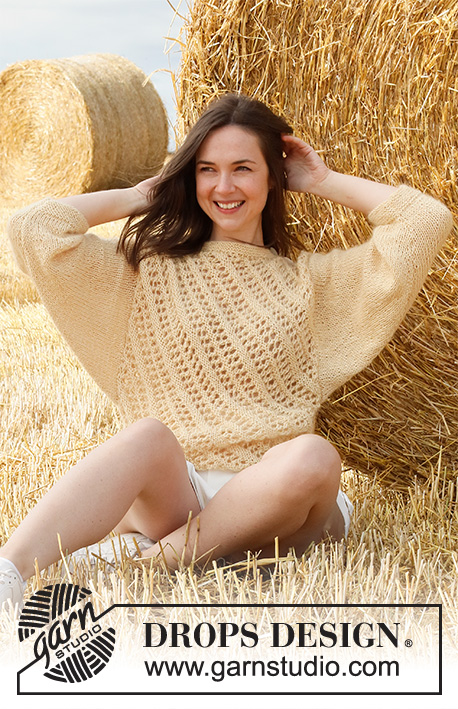 |
|||||||||||||||
Knitted sweater in DROPS Baby Alpaca Silk and DROPS Kid-Silk. The piece is worked with lace pattern and ¾-length sleeves in stockinette stitch and with garter stitch edges. Sizes S - XXXL.
DROPS 223-26 |
||||||||||||||||
|
------------------------------------------------------- EXPLANATIONS FOR THE PATTERN: ------------------------------------------------------- RIDGE/GARTER STITCH (worked back and forth): Knit all rows. 1 ridge in height = Knit 2 rows. PATTERN: See diagrams A.1 and A.2. The diagrams show all the rows in the pattern from the right side. INCREASE TIP-1 (for each side of the front and back pieces and for the sleeves): All increases are worked from the right side! Increase 1 stitch on the inside of the 1 edge stitch by making 1 yarn over. On the next row work the yarn over twisted to avoid a hole. Then work the new stitch into A.1/A.2 on the front and back piece and in stockinette stitch on the sleeves. DECREASE TIP (for each side of the front and back pieces): All decreases are worked from the right side! DECREASE AS FOLLOWS AFTER THE 1 EDGE STITCH: Slip 1 stitch as if to knit, knit 1 and pass the slipped stitch over the knitted stitch. DECREASE AS FOLLOWS BEFORE THE 1 EDGE STITCH: Work until there are 2 stitches left before the edge stitch and knit these 2 stitches together. MEASURING TIP: It is important that the measurements are taken when the piece lays flat. The structure may tighten the piece in height - pull slightly when measuring, and make sure the front and the back piece are the same size. INCREASE TIP-2 (evenly spaced): To work out how to increase evenly, count the total number of stitches on the needle (e.g. 42 stitches) minus the edge stitches (e.g. 2 stitches) and divide the remaining stitches by the number of increases to be made (e.g. 8) = 5. In this example, increase by making 1 yarn over after each 5th stitch. On the next row work the yarn overs twisted to avoid holes. BINDING-OFF TIP: To avoid the bind-off edge being tight you can bind off with a larger size needle. If the edge is still tight, make 1 yarn over after approx. each 4th stitch at the same time as binding off; the yarn overs are bind off as normal stitches. ------------------------------------------------------- START THE PIECE HERE: ------------------------------------------------------- SWEATER – SHORT OVERVIEW OF THE PIECE: The piece is worked in sections, back and forth. The front and back pieces are worked diagonally, from corner to corner. The sleeves are worked bottom up. The piece is sewn together, then edges are worked in garter stitch on the one shoulder, around the neck and at the bottom of the body. FRONT PIECE: The front piece is worked from the bottom left corner to the top right corner, seen from the right side. Cast on 3 stitches with circular needle size 5 MM = US 8 and 1 strand of each quality (= 2 strands). The first row is worked as follows from the right side: 1 edge stitch in GARTER STITCH – read description above, increase 1 stitch – read INCREASE TIP-1, work A.1 (= 1 stitch), increase 1 stitch and finish with 1 edge stitch in garter stitch. Continue this pattern and increase on each side every 2nd row (every row from the right side). When A.1 has been completed in height (there are now 7 stitches on the row), work the next row as follows from the right side: 1 edge stitch in garter stitch, increase 1 stitch as before, work A.2A (= 1 stitch), A.2B (= 2 stitches), A.2C (= 2 stitches), increase 1 stitch and finish with 1 edge stitch in garter stitch. Continue this pattern and continue increasing on each side. A.2 is repeated in height; each time A.2 has been completed, there is room for 9 more repeats of A.2B between A.2A and A.2C. REMEMBER THE KNITTING GAUGE! Continue working until the piece measures 44-46-48-50-52-54 cm = 17¼"-18"-19"-19¾"-20½"-21¼" along the edges (do not measure in the knitting direction) – read MEASURING TIP. Insert 1 marker in each side. Continue increasing as before at the beginning of each row from the right side, but now decrease at the end of each row from the right side (number of stitches remains the same) - read DECREASE TIP. Increase and decrease like this until the piece measures 2-4-6-8-12-16 cm = ¾"-1½"-2⅜"-3⅛"-4¾"-6¼" from the markers in the sides. Then decrease 1 stitch on each side, inside both edge stitches. Decrease like this every 2nd row (each row from the right side) until there are 3 stitches left. Knit these 3 stitches together. Cut the strand and pull it through the last stitch. The front piece measures approx. 44-46-48-50-52-54 cm = 17¼"-18"-19"-19¾"-20½"-21¼" along the shortest sides (= length of sweater) and 46-50-54-58-64-70 cm = 18"-19¾"-21¼"-22¾"-25¼"-27½" along the longest sides (= width of sweater). An edge of 4 cm = 1½" will be worked on the front and back pieces to finish and comes in addition to the 44-46-48-50-52-54 cm = 17¼"-18"-19"-19¾"-20½"-21¼" in length. BACK PIECE: Work in the same way as the front piece. SLEEVES: Cast on 42-44-46-48-50-52 stitches (including 1 edge stitch on each side) with circular needle size 4 MM = US 6 and 1 strand of each quality (= 2 strands). Work garter stitch back and forth for 4 cm = 1½". Change to circular needle size 5 MM = US 8. Work stockinette stitch with 1 edge stitch in garter stitch on each side – AT THE SAME TIME, on the first row from the right side, increase 10-14-18-18-22-26 stitches evenly spaced – read INCREASE TIP-2 = 52-58-64-66-72-78 stitches. When the piece measures 6 cm = 2⅜" in all sizes, increase 1 stitch on each side – read INCREASE TIP-1. Increase like this every 1½ cm = ½" a total of 23-22-21-21-20-19 times on each side = 98-102-106-108-112-116 stitches. Continue working until the sleeve measures 40-39-38-38-36-34 cm = 15¾"-15¼"-15"-15"-14¼"-13⅜" (shorter measurements in larger sizes due to broader shoulders). Now bind off 16-16-16-18-18-18 stitches at the beginning of each row a total of 2 times on each side = 34-38-42-36-40-44 stitches left. Bind off – read BINDING-OFF TIP! The sleeve measures approx. 42-41-40-40-38-36 cm = 16½" -16⅛"-15¾"-15¾"-15"-14¼" from the top down. Work the other sleeve in the same way. ASSEMBLY-1: Lay the front and back pieces together. Mark a neck of approx. 24-26-26-28-28-30 cm = 9½"-10¼"-10¼"-11"-11"-11¾". There will be 11-12-14-15-18-20 cm = 4⅜"-4¾"-5½"-6"-7"-8" left on each side for the shoulders. Sew one shoulder inside the 1 edge stitch – sew from the marker on the neck out to the side. BUTTON BAND ON SHOULDER: Work a garter stitch edge along the other shoulder, both on the front and back pieces for the button-bands as follows: Start on the front piece and knit up from the right side, inside the 1 edge stitch, 20-22-26-26-32-36 stitches along the shoulder with circular needle size 4 MM = US 6 and 1 strand of each quality. Knit 1 row from the wrong side. Knit 1 row from the right side where you work 2 buttonholes evenly spaced. 1 BUTTONHOLE = Bind off 2 stitches and cast on 2 stitches over these stitches on the next row. Knit 1 row from the wrong side. Bind off with knit from the right side. Work a similar edge on the back piece, but without buttonholes. NECK: Start from the right side on the shoulder and knit up inside the 1 edge stitch 90 to 112 stitches around the neck and along the edge of the button bands, with circular needle size 4 MM = US 6 and 1 strand of each quality. Work garter stitch back and forth for 2 cm = ¾", but after ½ cm = ⅛", work 1 buttonhole when there are 4 stitches left on the row from the right side. When the neck is finished bind off with knit from the right side – read BINDING-OFF TIP! Sew on the buttons. EDGE AT BOTTOM OF SWEATER: Start on the front piece and knit up from the right side inside the 1 edge stitch 86-94-102-110-122-132s stitches along the bottom edge with circular needle size 4 MM = US 6 and 1 strand of each quality. Work garter stitch back and forth for 4 cm = 1½". Bind off with knit from the right side – remember BINDING-OFF TIP! Work a similar edge along the back piece. ASSEMBLY-2: Insert 1 marker 29-30-31-32-33-34 cm = 11⅜"-11¾"-12¼"-12½"-13"-13⅜" down from the shoulder on each side of the front and back pieces; they mark the armholes. Sew the sleeves into the marked armholes – sew inside the 1 edge stitch and make sure the seam is not tight. Sew the sleeve and side seams in one go, inside the 1 edge stitch – start at the bottom of the sleeve, work up the sleeve and then down the side, stopping at the garter stitch edge at the bottom of the sweater, leaving a small split. The sweater measures approx. 48-50-52-54-56-58 cm = 19"-19¾"-20½"-21¼"-22"-22¾" from the shoulder down. |
||||||||||||||||
Diagram explanations |
||||||||||||||||
|
||||||||||||||||
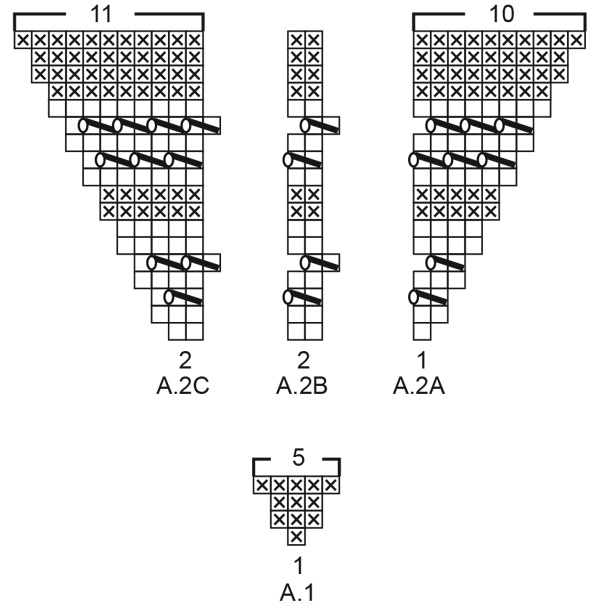
|
||||||||||||||||

|
||||||||||||||||
|
Have you made this or any other of our designs? Tag your pictures in social media with #dropsdesign so we can see them! Do you need help with this pattern?You'll find tutorial videos, a Comments/Questions area and more by visiting the pattern on garnstudio.com. © 1982-2024 DROPS Design A/S. We reserve all rights. This document, including all its sub-sections, has copyrights. Read more about what you can do with our patterns at the bottom of each pattern on our site. |
||||||||||||||||







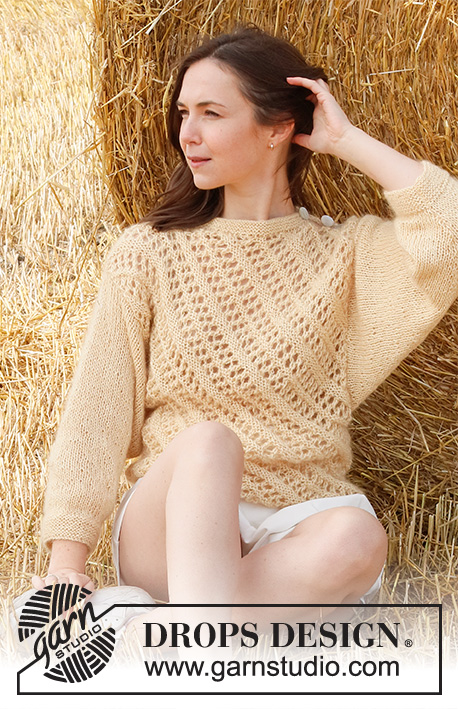

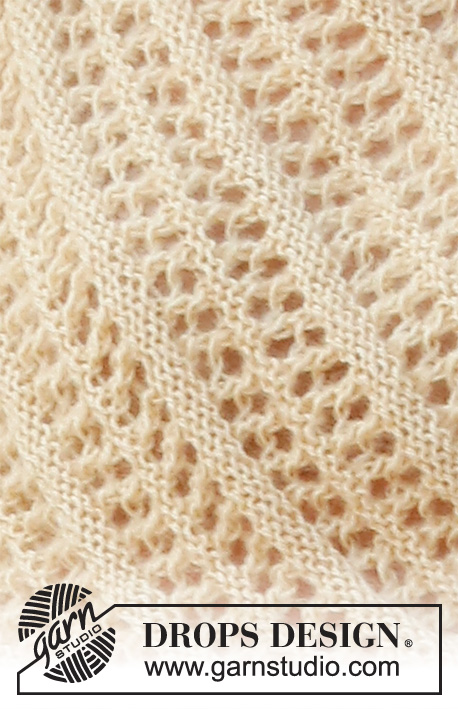

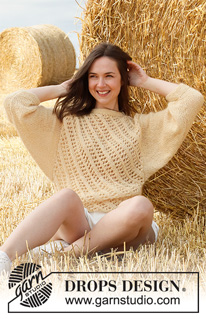
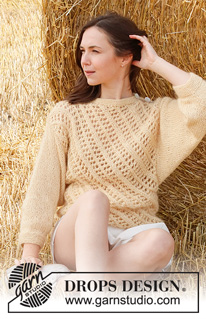
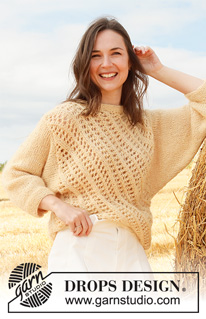




















































Comments / Questions (8)
Hallo, er staat dat garengroep C ook kan gebruikt worden. kan ook bv. Drops Brushed alpaca silk? Of welke andere geeft hetzelfde effect als baby Alpaca silk (deze is uitverkocht). dank u wel
05.03.2024 - 10:11DROPS Design answered:
Dag Dee,
De trui wordt met 2 draden Baby Alpaca Silk gebreid, dus 2 draden van dikte A. Waarschijnlijk komt Alpca of Flora het meest in de buurt. Brushed Alpaca Silk heeft een ander effect.
05.03.2024 - 22:29Cosa significa capo di qualità? È sinonimo di maglia a vivagno? Grazie dell'attenzione, cordiali saluti. Valentina
18.10.2021 - 22:25DROPS Design answered:
Buonasera Valentina, con 1 capo di ogni qualità si intende 1 filo per ognuno dei 2 filati utilizzati. Buon lavoro!
19.10.2021 - 23:14Hi, how can I convert the pattern to a XS size? I want to knit this beautiful sweater for my 12 yr grand daughter. Thanks for your help.
13.05.2021 - 04:21DROPS Design answered:
Hi Ranjana, unfortunately we are not able to adjust our patterns to any individual requests. Should you need any individual assistance, please contact the store where you bought the yarn, even per mail or telephone. Happy knitting!
13.05.2021 - 15:46è molto bello! Peccato che, per il momento, non si veda il diagramma da seguire e l'immagine del modello con le misure
09.04.2021 - 09:49DROPS Design answered:
Buonasera Silvia, durante la giornata ci sono stati alcuni problemi di visualizzazione delle immagini, al momento per fortuna risolti. Buon lavoro!
09.04.2021 - 22:48Sommerwind
20.01.2021 - 13:03Rejoice
10.01.2021 - 23:37Fresco ed originale. Sarà il prossimo che realizzerò
08.01.2021 - 09:16Elegant Sky
07.01.2021 - 20:09